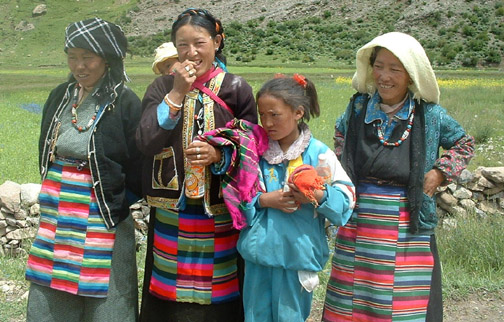Bio (1)
Gansu (4)
Hangzhou (5)
Not in China (1)
Read about China (8)
Shaanxi (2)
Sichuan (1)
Teaching (4)
Tibet (4)
Xinjiang (5)
* Web update
* Goodbye, Hangzhou
* Gyantse and our last days in Tibet
* Don't come to China in July
* Mt. Qomolangma, where are you?
* Road Trip Tibet
* China's Wild West
* Jiuzhaigou: An itinerary
* Lhasa
* Warrior Madness
* Xi'an and a change of plans
* Togetherness, two volkswagens and a two dollar tow home
* Yarkand (or, Car Can't)
* A view of the Karakoram
* The Craziest Market Ever
* The Holy Man
* Dunhuang to Turpan
* "Little Tibet of China"
* Rick's 250-mile bike ride
August 02, 2004

Three Tibetan women and their children on the road from Lhasa to Shigatse.
The monk guarding the doorway to the meeting hall at Sakya Monastery gestured for us to enter. I was somewhat reluctant -- everyone inside was barefoot and wearing a crimson robe, chanting something we could not understand.
But Judy and I, and our two travel companions we met back in Lhasa -- Valeria and Jacqueline -- entered the dark hall anyway. The monks sitting on their raised benches covered with Tibetan carpets gestured to us that we should walk around the room clockwise to view the buddha statues and interior decorations.
Some stiffled giggles or quickly turned away as we walked through their evening session. I felt like an intruder, but no one really seemed to mind to have four Western women parade around the meeting hall -- it seemed we were part of the night's entertainment.
After one walk around the hall, I stepped outside, where a few monks waited with everyone's shoes. Suddenly the chanting stopped, and the entire room of monks ran straight for the door. Unfortunately I was in the middle of all the shoes, and tried, but failed, to get out of the way.
Sakya was the second town we stopped at on our seven-day road trip through Tibet. The night before we had already stopped in Shigatse, the former home of the Panchen Lama.
Shigatse, though smaller than Lhasa, was much bigger than I expected, and bears the unfortunate mark of China -- white-tile buildings, wide avenues and buildings with Chinese-ified upturned roof tiles and wood carvings. But there is still the old town of Tibetan-style, white-washed houses with piles of sticks and dung collected for the approaching winter. (It seems winter is always approaching on the Tibetan plateau, even in the middle of July.)
The day we left Shigatse for Sakya, Judy and I wandered through the unpaved, narrow streets of the old town to get to the Shigatse fort that looms over the city. Although it still resembles the shape of a fort, it is also crumbling so much at parts that it is hard to tell what part is the fort and what is part of the hill.
Sakya was only a 3-hour drive from Shigatse (our driver had it easy after an 8-hour drive from Lhasa to Shigatse), but seemed to be a world away.
The only "new" building in Sakya was the four-month-old hotel we stayed in. Although it was only two stories tall and its architecture was modeled after traditional Tibetan homes, the hotel dwarfed the surrounding buildings. Sakya's structures were a bit different than what we had already seen in the countryside. Instead of the standard white walls, Sakya's houses were grey with red and white vertical stripes.
There is no old town and new town in Sakya, for now it is only the old town. And perhaps that's why Sakya sticks out in my mind as the highlight of my time in Tibet. Though it is commonly on most visitors' itinerary, it seemed relatively untouched by outsiders.
Before entering the Sakya monastery, the four of us stopped to check out the two souvenir stands on the main drag. (Only two souvenir stands! Totally unheard of in China!) The man at one was drinking beer, and invited Judy and I to join him. The locals watching us giggled as Judy and I drank down shot glasses of beer. Meanwhile, his wife was trying her best to sell us cow bells, insence holders and medalions.
We explored the the monastery on our own, and were fascinated by the exterior of the "protector chapel" -- the door of which was decorated with stuffed (once living) wolves, racoons and and other wildlife. The chapel was not open, but the monks at the meeting hall said we could come back in the morning to see it. We were determined to.
With plenty of time before dark, the four of us wandered across the river across from our hotel. As we walked on a path, some curious Tibetan women followed us with their children. We kept walking while they stopped at their houses. Only a few steps later some more children found us. Clearly they had met other travelers, because they instantly started asking for money, pencils and food. Instead we took our our digital cameras and snapped away. After each picture the children would run toward us to see their faces.
After the photo shoot, the children wandered around with us, holding our hands and playing clapping games. We wandered back into town, and the children returned home.
The next day we left for Rongpu monastery, the highest monastery in the world (4,900 meters), only 8 km from Everest Base Camp.
More photos:
A mural at the Tashilhunpo Monastery in Shigatse, the former home of the Panchen Lama.